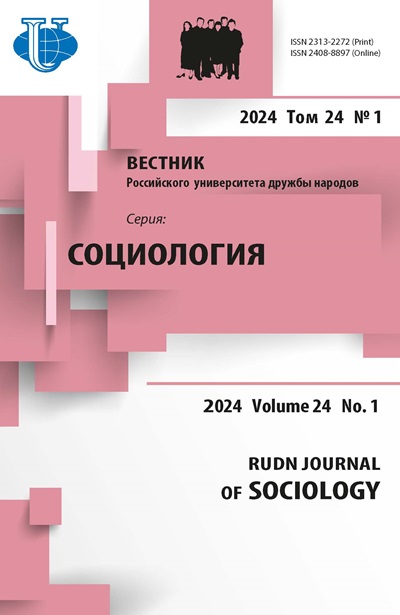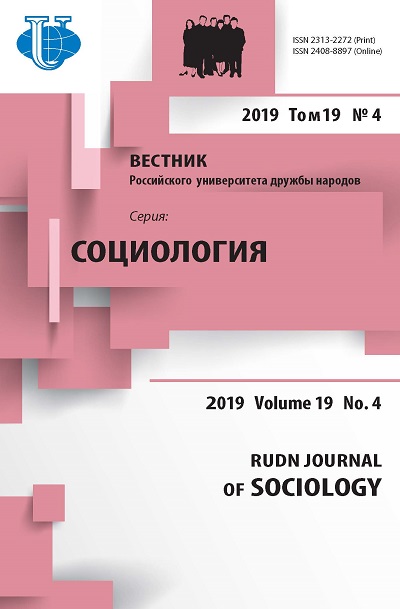The birth rate in BRICS countries under the gender inequality in the labor market
- Authors: Kizilova K1, Mosakova EA2
-
Affiliations:
- Institute for Comparative Survey Research “Eurasia Barometer”
- Lomonosov Moscow State University
- Issue: Vol 19, No 4 (2019)
- Pages: 630-638
- Section: Contemporary society: the urgent issues and prospects for development
- URL: https://journals.rudn.ru/sociology/article/view/22087
- DOI: https://doi.org/10.22363/2313-2272-2019-19-4-630-638
Cite item
Full Text
Abstract
Demographic security under the uneven replacement of population due to significant fluctuations in birthrates is one of the most important problems for many states and global communities. According to the numerous studies, the developed countries face the challenge of depopulation and need to increase fertility, while the developing countries experience demographic boom and need to reduce fertility. The article considers the dynamics of fertility rates in the BRICS countries in the context of gender inequality in labor relations. The authors show that gender discrimination in labor relations affects fertility. The BRICS countries demonstrate that the lower birthrate the higher the level of women’s employment, of women’s wages, of gender equality in the economic sphere, and the larger the share of female students in the higher education. For the contemporary Russian society this correlation is reverse. The BRICS group consists mainly of developing countries, whose demographic transition has not yet been completed. For this reason, these countries demonstrate a negative correlation between fertility and gender inequality in the labor market. According to the sociological research findings, women there are still challenged with the choice between family and employment. Significant gender inequality in the labor market is an additional factor that forces women into the sphere of family employment. Gender discrimination in the labor market in Russia has a completely different impact on the birthrate than in other BRICS countries: a lower level of gender inequality in the labor market, on the contrary, contributes to the higher fertility. On the one hand, the higher level of gender equality in the labor market makes it easier for women to combine family employment and career, which results in larger number of children per family. On the other hand, the tradition to have several children declines. Therefore, the gender equality policy in a long run determines a smaller number of children per family in the future.
Keywords
About the authors
K Kizilova
Institute for Comparative Survey Research “Eurasia Barometer”
Author for correspondence.
Email: ksenniya.kizilova@gmail.com
заместитель директора Института сравнительных исследований общественного мнения «Евразийский барометр» (Вена, Австрия), старший научный сотрудник социологического факультета Харьковского национального университета имени В.Н. Каразина; руководитель секретариата Исследовательской ассоциации «Мировые ценности» (Стокгольм, Швеция)
Paniglgasse 17/7, Vienna, 1040, AustriaE A Mosakova
Lomonosov Moscow State University
Email: lizavetam@mail.ru
кандидат экономических наук, доцент кафедры ЮНЕСКО по изучению глобальных проблем факультета глобальных процессов
Leninskye Gory, 1, bldg. 13a, Moscow, Russia, 119991References
- Ahn N., Mira P. A note on changing relationship between fertility and female employment rates in developed countries. Journal of Population Economics. 2002; 15.
- Anderson G., Scott K. Childbearing dynamics of couples in a universalistic welfare state: The role of labor-market status, country of origin, and gender. Demographic Research. 2007; 17.
- Andersson G., Liu G. Demographic trends in Sweden: Childbearing developments in 1961—2000, marriage and divorce developments in 1971—1999. Demographic Research. 2001; 5.
- Andorka R. Determinants оf Fertility and Advanced Societies. New York: Free Press; 1978.
- Heеr D. Society аnd Population. Englewood Cliffs: Рrеnticе-Наll; 1968.
- Hoem B. Entry into motherhood in Sweden: The influence of economic factors on the rise and fall in fertility 1986—1997. Demographic Research. 2000; 2.
- Hоеm B. Тhе compatibility of employment and childbearing in contemporary Sweden. Acta Sociologica. 1993; 36.
- Kharkova T.L., Andreev E.M. Did the economic crisis cause the fertility decline in Russia? Evidence from the 1995 micro-census. European Journal of Population. 2000; 16.
- Kohler H.P., Kohler I. Fertility decline in Russia in the early and mid-1990s: The role of economic uncertainty and labor market crisis. European Journal of Population. 2001; 18.
- Lloyd С. The contribution of the world fertility surveys to an understanding of the relationship between women’s work and fertility. Studies in Family Planning. 1991; 22 (3).
- Myrdal А., Кlein У. Women’s Two Roles: Home and Work. London: Routledge; 1956.
- Sweet J.A. Woman in the Labor Force. New York: Seminar Press; 1973.
- Tevenon O. Family policies in developed countries: Contrasting models. Population & Societies. 2008; 448.
- The World Factbook: TFR by countries of the world. 2017. https://www.cia.gov/library/ publications/resources/the-world-factbook/geos/ch.html.
- Transforming Our World: The 2030 Agenda for Sustainable Development. United Nations; 2015.
- World Economic Forum: The Global Competitiveness Report. 2017. http://www3.weforum.org/ docs/WEF_GGGR_2017.pdf.
- Barinova Yu.A., Suslov S.A. Food security, agricultural development and demographic trends in some RF territories. NGIEI Bulletin. 2013; 1 (In Russ.).
- Bunkovsky D.V. Shadow economy: A development analysis. Bulletin of the East-Siberian Institute of the Russian Ministry of Interior. 2015; 4 (In Russ.).
- Women and Men in Russia. 2006: Statistical Digest. Moscow; 2007 (In Russ.).
- Women and Men in Russia. 2016: Statistical Digest. Moscow; 2016 (In Russ.).
- Education by Numbers: 2017: A Brief Statistic Digest. Moscow; 2017 (In Russ.).
- Work and Employment in Russia: 2003: Statistical Digest. Moscow; 2003 (In Russ.).
- Work and Employment in Russia: 2015: Statistical Digest. Moscow; 2015 (In Russ.).
- Work and Employment in Russia: 2017: Statistical Digest. Moscow; 2017 (In Russ.).
- State Statistics Federal Service of the Russian Federation: Relationship between Women’s and Men’s Wages. http://www.gks.ru/wps/wcm/connect/rosstat_main/rosstat/ru/statistics/wages/ labour_costs/# (In Russ.).
- State Statistics Federal Service of the Russian Federation: TFR in Russia. http://www.gks.ru/ wps/wcm/connect/rosstat_main/rosstat/ru/statistics/population/demography/# (In Russ.).














